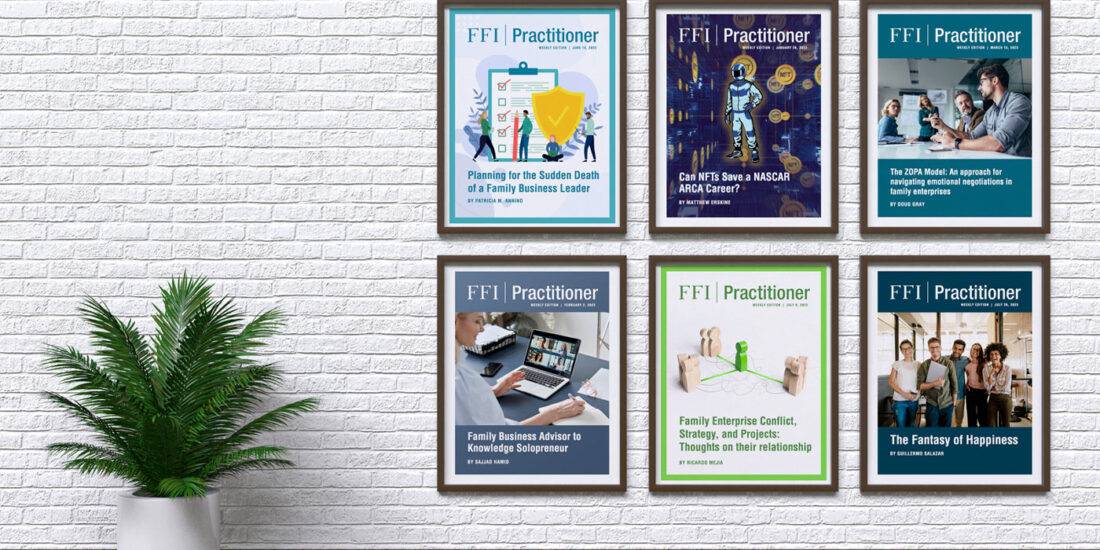Around the World in Four Recaps
 In this year’s final installment of Karen Vinton’s Executive Summaries, The Practitioner recaps four stellar research articles, with a true overall international bent. The recap of the first article touches upon family-to-work conflicts within Chinese companies, the second recap debates “nepotism-versus-outside talent” with management in Italian firms, while the third recap examines successful South African sibling teams. And rounding things out, Karen’s last article recap attempts to define the role of research in general. We hope these compelling summaries provide you with thoughtful intelligence that carries you through the Holidays and into 2013, as we continue to bring you the latest and greatest in family enterprise advisory research!
In this year’s final installment of Karen Vinton’s Executive Summaries, The Practitioner recaps four stellar research articles, with a true overall international bent. The recap of the first article touches upon family-to-work conflicts within Chinese companies, the second recap debates “nepotism-versus-outside talent” with management in Italian firms, while the third recap examines successful South African sibling teams. And rounding things out, Karen’s last article recap attempts to define the role of research in general. We hope these compelling summaries provide you with thoughtful intelligence that carries you through the Holidays and into 2013, as we continue to bring you the latest and greatest in family enterprise advisory research!
SUMMARY 1: Effects of Family-to-Work Conflict on Business Owners: The Role of Family Business
By Ho Kwong Kwan, Victor P. Lau and Kevin Au
The authors of this article describe family-to-work conflict (FWC) as the extent to which issues in the family produce conflict at work and when issues at work produce conflict in the family. This study looks at a sample of 158 Chinese business owners and found that for non-family businesses, the relationship between owners’ FWC and job satisfaction is negative, whereas the relationship between their FWC and social networks is positive, suggesting that in non-family businesses, as family issues conflict with work, business owners’ job satisfaction declines and they seek social relationships and networks outside of the family. On the other hand, family business owners’ FWC is unrelated to their job satisfaction and social networks.
These findings suggest that family business owners are more likely to have emotional support and effective coping strategies, not found in non-family firms, which alleviate the negative effects of FWC on job satisfaction.
Even though this is a preliminary study of these variables and more studies are required, the article presents one particularly interesting thing to think about: is it possible that family business owners who participate in networking groups, such as university family business centers, YPO, TEC, CAFÉ, FBN or Vistage, can achieve greater job satisfaction than those who do not participate in such networking groups? These various networking groups might want to consider pursuing research along this line.
SUMMARY 2: Faster Route to the CEO Suite: Nepotism or Managerial Proficiency?
By Carlo Salvato, Alessandro Minichilli, and Raffaella Piccarreta
This article investigates the differences between the careers of CEOs in family and nonfamily firms by examining the careers of 100 CEOs of large Italian firms from graduation to their first CEO appointment. Of the 100 firms examined, 58 were family firms and 42 were nonfamily firms, mirroring the proportion of family/nonfamily firms in Italy.
The three key findings are as follows:
- Forty six of the 58 family firms were headed by a nonfamily CEO who had spent most of his/her career outside of the family firm. Only 6 (4 family CEOs and 2 nonfamily CEOs) of the 58 family firm CEOs spent their entire career in the family firm.
- Managerial careers of both family and nonfamily managers are quicker in family firms. It was found in this sample that family managers reach the penultimate position, reporting to the CEO, faster than nonfamily managers. However, once a manager reaches this position, nonfamily managers became CEO more quickly than family managers.
- No significant differences were found in CEO career traits. Career traits were more dependent on the firms’ managerial needs than on their ownership structure.
These results should provide food for thought for practitioners and family business owners and managers. For example, next generation family members might consider this evidence when planning their own career paths. This study shows that intra-organizational career paths are rare, so next generation family members might want to consider gaining experience outside of the family firm. This could be especially important since they may one day be competing against nonfamily executives for top positions in the family firm. These results can also be used by practitioners when helping family firms develop leadership development programs for their family members.
It will be interesting to see if future research finds similar results in smaller firms and in other countries.
SUMMARY 3: The Role of Selected Team Design Elements in Successful Sibling Teams
By Shelley Maeva Farrington, Elmarie Venter and Christo Boshoff
Practitioners working with family businesses and business families to build and develop effective teams will find this article thought provoking. The authors collected data from 371 South African individuals who work in a sibling team context and identified five team design elements which influence the success of a sibling team: strategic leadership, physical resources, skills diversity, competence and role clarity. Success was measured using two variables: perceived financial performance and family harmony.
The study found that three of the factors influenced team performance: (1) availability of physical resources necessary to complete the tasks, (2) diversity of skills within the team, and (3) strategic planning to build agreement on goals and vision. The two other design elements, competence and role clarity, were not found to significantly influence team performance or family harmony. Surprisingly, there was no support for the hypothesis that there was a positive relationship between family harmony and perceived financial performance of the sibling team.
The authors propose several useful suggestions for practitioners working with sibling teams:
- Practitioners should use interventions tailored to the specific family business situation and not rely on a “standard” approach to teamwork. The same determinants of effectiveness may not always apply to all types of teams.
- Sibling teams require skill diversity which raises the challenge of finding positions in the business which best fit the competencies, personality and style of each sibling. Also it is important for each sibling to accept the role for which he or she is best suited.
- Sibling teams require the necessary physical resources and information to complete the task at hand.
- Sibling teams should work together to develop strategic plans in order to develop agreement about goals and vision.
This article reports the findings from interviews with six scholars (Professors Howard Aldrich, Michael Hitt, Duane Ireland, Luis Gomez-Mejia, Manfred Kets de Vries, and Mike Wright) and explores what is distinctive about family business research, the design of research, and the direction research should be going. Some of the findings that will resonate with practitioners include:
- Family business is at the boundary of many fields and it’s important to get a grounding in a field other than your primary field.
- Socioemotional wealth (the “non-financial aspects of the firm that meet the family’s affective needs”) is a promising concept “being used to explain a variety of phenomena in family firms” (p. 114).
- “Family business is not bloodless like other research” (p. 115).
- Family businesses “orchestrate resources differently” (p. 115).
A look into the world of researchers offers an understanding of the ways in which practitioners are similar and different from researchers in their perspectives—another important step in collaboration.
Download Article Here
Yours in Practice,
The Practitioner




